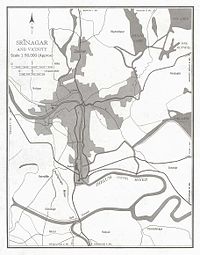Srinagar is the largest city and the summer capital of the Indian state of Jammu and Kashmir. It lies on the banks of the Jhelum River, a tributary of the Indus, and Dal and Anchar lakes. The city is famous for its gardens, waterfronts and houseboats. It is also known for traditional Kashmiri handicrafts and dried fruits.
With the disintegration of the Mughal empire after the death of Aurangzeb in 1707, infiltrations to the valley from the Pashtun tribes increased, and the Durrani Empire ruled the city for several decades.
History
Ancient period
The Burzahom archaeological site located 10 km from Srinagar has revealed the presence of neolithic and megalithic cultures.
According to Kalhana's 12th century text Rajatarangini, a king named Pravarasena II established a new capital named Pravarapura (also known as Pravarasena-pura). Based on topographical details, Pravarapura appears to be same as the modern city of Srinagar. Aurel Stein dates the king to sixth century CE.
Kalhana also mentions that a king named Ashoka had earlier established a town called Srinagari. Kalhana describes this town in hyperbolic terms, stating that it had "9,600,000 houses resplendent with wealth". According to Kalhana, this Ashoka reigned before 1182 BCE, and was a member of the dynasty founded by Godhara. Kalhana also states that this king had adopted the doctrine of Jina, constructed stupas and Shiva temples, and appeased Bhutesha (Shiva) to obtain his son Jalauka. Multiple scholars identify Kalhana's Ashoka with the 3rd century Buddhist Mauryan emperor Ashoka despite these discrepancies.Although "Jina" is a term generally associated withJainism, some ancient sources use it to refer to the Buddha. Romila Thapar equates Jalauka to Kunala, stating that "Jalauka" is an erroneous spelling caused by a typographical error in Brahmi script.
Ashoka's Srinagari is generally identified with Pandrethan (near present-day Srinagar), although there is an alternative identification with a place on the banks of the Lidder River. According to Kalhana, Pravarasena II resided at Puranadhishthana ("old town") before the establishment of Pravarapura; the name Pandrethan is believed to be derived from that word.Accordining to V. A. Smith, the original name of the "old town" (Srinagari) was transferred to the new town.[11]
Srinagar in 14th to 19th centuries
The independent Hindu and the Buddhist rule of Srinagar lasted until the 14th century when the Kashmir valley, including the city, came under the control of the several Muslim rulers, including the Mughals. It was also the capital during the reign of Yusuf Shah Chak, an Independent Kashmiri ruler who was tricked by Akbar when Akbar failed to conquer Kashmir by force. Yusuf Shah Chak remains buried inBihar. Akbar established Mughal rule in Srinagar and Kashmir valley.
With the disintegration of the Mughal empire after the death of Aurangzeb in 1707, infiltrations to the valley from the Pashtun tribes increased, and the Durrani Empire ruled the city for several decades.
Maharaja Ranjit Singh of Punjab province annexed a major part of the Kashmir Valley, including Srinagar, to his kingdom in the year 1814 and the city came under the influence of the Sikhs.
In 1846, the Treaty of Lahore was signed between the Sikh rulers and the British in Lahore. The treaty inter alia provided British de facto suzerainty over the Kashmir Valley and installed Gulab Singh as an independent and sovereign ruler of the region. Srinagar became part of his kingdom and remained until 1947 as one of several princely states inBritish India. The Maharajas choose Sher Garhi Palace as their main Srinagar residence.
Post Independence
After India and Pakistan's independence from Britain, villagers around the city of Poonch began an armed protest at continued rule of the Maharaja on 17 August 1947. In view of the Poonch uprising, certain Pashtun tribes such as Mehsud and Afridi from mountainous region of Khyber Pakhtunkhwa of Pakistan and with its collusion, entered the Kashmir valley to capture it on 22 October 1947. The Maharaja, who had refused to accede to either India or Pakistan in hopes of securing his own independent state, signed the instrument of accession in exchange for refuge on 26 October 1947, as Pakistani-backed tribesmen approached the outskirts of Srinagar. The Accession was accepted by India the next day. The government of India immediately airlifted Indian troops to Srinagar and prevented the tribesmen from reaching the city.
In 1989, Srinagar became the focus of the Kashmiri uprising against Indian rule and the Indian military, which has been present since 1990, and the area continues to be a highly politicized hotbed of separatist activity with frequent spontaneous protests and strikes ("bandhs" in local parlance). On 19 January 1990, the Gawakadal massacre of at least 50 unarmed protestors by Indian forces,and up to 280 by some estimates from eyewitness accounts,set the stage for bomblasts, shootouts, and curfews that characterized Srinagar throughout the early and mid-1990s. Further massacres in the spring of 1990 in which 51 unarmed protesters were allegedly killed by Indian security forces in Zakura and Tengpora heightened anti-Indian sentiments in Srinagar. As a result, bunkers and checkpoints are found throughout the city, although their numbers have come down in the past few years as militancy has declined. However, frequent protests still occur against Indian rule, such as the 22 August 2008 rally in which hundreds of thousands of Kashmiri civilians protested against Indian rule in Srinagar. Similar protests took place every summer for the next 4 years. In 2010 alone 120 unarmed protestors were killed by police and CRPF, most recently protest following the execution of Afzal Guru in February 2013.
The city also saw increased violence against minorities, particularly the Kashmiri Hindus, starting from mid-80s and resulting in their ultimate exodus.Posters were pasted to walls of houses of Pandits, telling them to leave or die, temples were destroyed and houses burnt;but a very small minority of pandits still remains in the city. The recent years have seen protests in Srinagar from local Kashmiri pandits for protection of their shrines in Kashmir and their rights.


No comments:
Post a Comment